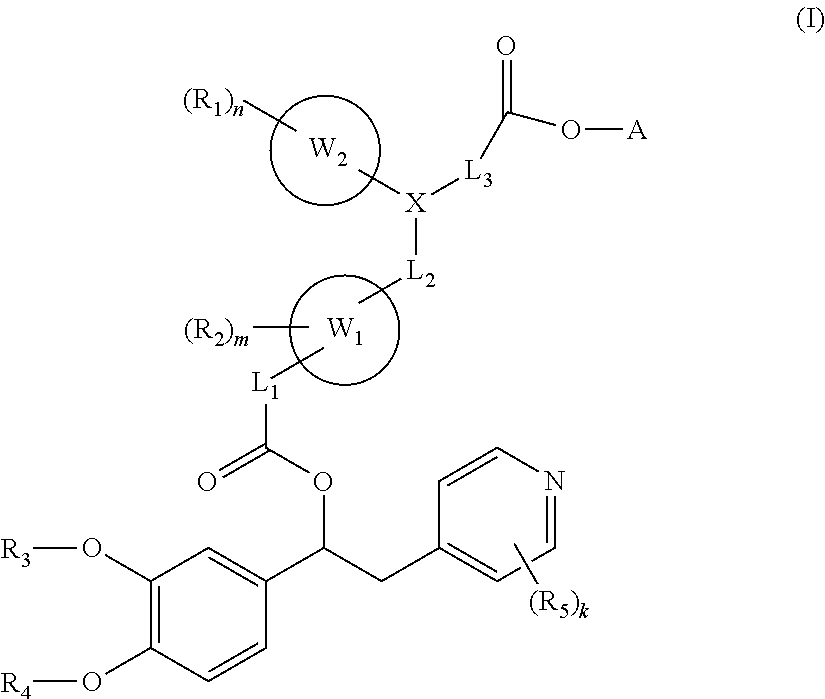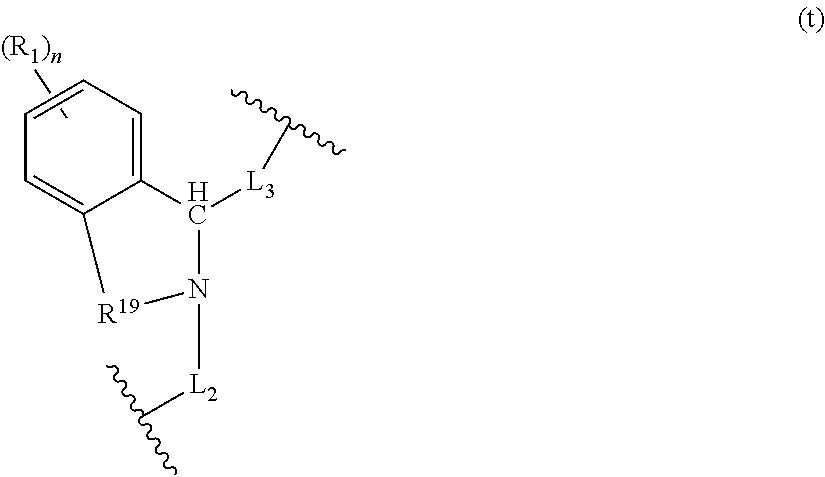Heteroaryl derivatives
a technology of heterocyclic compounds and derivatives, applied in the field of compounds, can solve the problems of affecting the effect of binding to muscarinic receptors outside the respiratory tract, and causing tachycardia, etc., and not addressing the underlying chronic inflammation or the changes in the airway structur
- Summary
- Abstract
- Description
- Claims
- Application Information
AI Technical Summary
Benefits of technology
Problems solved by technology
Method used
Image
Examples
example 1
[(1S)-2-(3,5-dichloro-1-oxido-pyridin-1-ium-4-yl)-1-(3,4-dimethoxyphenyl)ethyl]5-[(2-fluoro-N-[(3R)-quinuclidin-3-yl]oxycarbonyl-anilino)methyl]thiophene-2-carboxylate formate salt (E1)
[0470]
[0471]A microwave tube was charged with [(1S)-2-(3,5-dichloro-1-oxido-pyridin-1-ium-4-yl)-1-(3,4-dimethoxyphenyl)ethyl]5-[(2-fluoroanilino)methyl]thiophene-2-carboxylate (50 mg, 0.09 mmol), (R)-quinuclidin-3-yl carbonochloridate hydrochloride (81 mg, 0.36 mmol) and anhydrous acetonitrile (0.8 mL). The mixture was heated at 80° C. for 3 minutes under microwave irradiation. The reaction was evaporated to dryness. The residue was dissolved in DMSO (1.5 mL) and purified by preparative HPLC to afford [(1S)-2-(3,5-dichloro-1-oxido-pyridin-1-ium-4-yl)-1-(3,4-dimethoxyphenyl)ethyl]5-[(2-fluoro-N-[(3R)-quinuclidin-3-yl]oxycarbonyl-anilino)methyl]-thiophene-2-carboxylate formate salt as a white solid (26 mg, 41%).
[0472]1H NMR (400 MHz, CDCl3): δ 8.40 (s, 1H), 8.15 (s, 2H), 7.59 (d, J=3.6 Hz, 1H), 7.32-7.2...
example 24
[(1S)-2-(3,5-Dichloro-1-oxido-pyridin-1-ium-4-yl)-1-(3,4-dimethoxyphenyl)ethyl]5-[(3-hydroxy-N-[(3R)-quinuclidin-3-yl]oxycarbonyl-anilino)methyl]thiophene-2-carboxylate (E24)
[0477]
[0478]A mixture of 3-((trimethylsilyl)oxy)aniline (0.14 g, 0.77 mmol) and [(1S)-2-(3,5-dichloro-1-oxido-pyridin-1-ium-4-yl)-1-(3,4-dimethoxyphenyl)ethyl]5-formylthiophene-2-carboxylate (0.186 g, 0.39 mmol) in DCM (5 mL) was stirred at room temperature for 18 h. NaBH(OAc)3 (0.206 g, 0.97 mmol) and acetic acid (0.043 mL, 0.75 mmol) was added and the reaction mixture was stirred at room temperature for a further 3 h. The reaction mixture was diluted with DCM (10 mL) and washed with saturated aqueous NaHCO3 solution (25 mL). The aqueous phase was further extracted with DCM (10 mL), and the combined organic phases were washed with brine (20 mL), filtered through a phase separator cartridge and the solvent was removed in vacuo, co-evaporated with MeCN to give [(1S)-2-(3,5-dichloro-1-oxido-pyridin-1-ium-4-yl)-1-(...
example 26
[(1S)-2-(3,5-Dichloro-1-oxido-pyridin-1-ium-4-yl)-1-(3,4-dimethoxyphenyl)ethyl]5-[(2-fluoro-N-[(3R)-1-methylpyrrolidin-3-yl]oxycarbonyl-anilino)methyl]thiophene-2-carboxylate formate salt (E26)
[0481]
[0482]A solution of [(1S)-2-(3,5-dichloro-1-oxido-pyridin-1-ium-4-yl)-1-(3,4-dimethoxyphenyl)ethyl]5-[(2-fluoroanilino)methyl]thiophene-2-carboxylate (177 mg, 0.306 mmol) in acetonitrile (6 mL) was added with diphosgene (75 μL, 0.61 mmol) and the reaction mixture was stirred at room temperature for 5 minutes. After which time, a solution of diisopropylethylamine (341 μl, 2.0 mmol) and (R)-1-methylpyrrolidin-3-ol (220 μl, 2.0 mmol) in acetonitrile (3 mL) was added over 10 minutes. The brown mixture was stirred at room temperature for 1 h and then the solvent was removed in vacuo. The crude product was dissolved in chloroform (70 mL) and the organic layer was washed with HCl 1M (50 mL). The organic layer was dried over sodium sulfate and evaporated under vacuum. The crude material was puri...
PUM
| Property | Measurement | Unit |
|---|---|---|
| Force | aaaaa | aaaaa |
| Electrical conductance | aaaaa | aaaaa |
Abstract
Description
Claims
Application Information
 Login to View More
Login to View More - R&D
- Intellectual Property
- Life Sciences
- Materials
- Tech Scout
- Unparalleled Data Quality
- Higher Quality Content
- 60% Fewer Hallucinations
Browse by: Latest US Patents, China's latest patents, Technical Efficacy Thesaurus, Application Domain, Technology Topic, Popular Technical Reports.
© 2025 PatSnap. All rights reserved.Legal|Privacy policy|Modern Slavery Act Transparency Statement|Sitemap|About US| Contact US: help@patsnap.com



